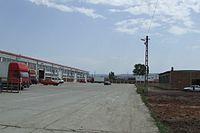- Kolozsvár Ghetto
-
The Kolozsvár Ghetto was one of the lesser-known Jewish ghettos of the World War II era. The ghetto was located in the city of Cluj (now Cluj-Napoca), then part of Hungary and called Kolozsvár. Prior to the Second Vienna Award in 1940, Cluj was a part of Romania. In 1947, the Paris Peace Treaties returned Northern Transylvania (including Cluj) to Romania.
History
On 3 May 1944, the ghettoization of the Cluj Jews began. The ghettoization was completed within a week. This was less than two months after the Germans launched Operation Margarethe, on 19 March. Operation Margarethe was the operation by which the German Army (Wehrmacht) placed Hungary under a puppet government, the Government of National Unity.
The Jews were concentrated in the Iris brickyard in the northern part of the city. This area consisted mostly of shacks used for drying bricks and tiles. The ghetto had practically no facilities for the approximately eighteen thousand Jews who were assembled there from Cluj and the surrounding Cluj County. The concentration of the Jews was carried out by the local administrative and police authorities with the cooperation of Protective Squadron (Schutzstaffel) advisers, including SS-Captain (SS-Hauptsturmfuhrer) Dieter Wisliceny. The ghetto was under the command of László Urbán, the police chief of Cluj. The ghetto's internal administration was entrusted to a Jewish Council (Judenrat). The members of this council included Fischer (as head), Rabbi Akiba Glasner, Rabbi Mozes Weinberger, and Ernő Márton. As in all the other ghettos in Hungary, the local brickyard also had a "mint," a special building where the police tortured Jews into revealing where they had hidden their valuables.
The Cluj Ghetto was liquidated in six transports to Auschwitz, with the first deportation occurring on May 25 and the last on June 9.
External links
- (Romanian) "135 de mii de evrei ucişi în Transilvania de Nord" ("135,000 Jews killed in Northern Transylvania"), Ziua, October 22, 2005.
Categories:- Jewish Romanian history
- Jewish Hungarian history
- World War II ghettos
- History of Cluj-Napoca
- The Holocaust in Hungary
Wikimedia Foundation. 2010.

